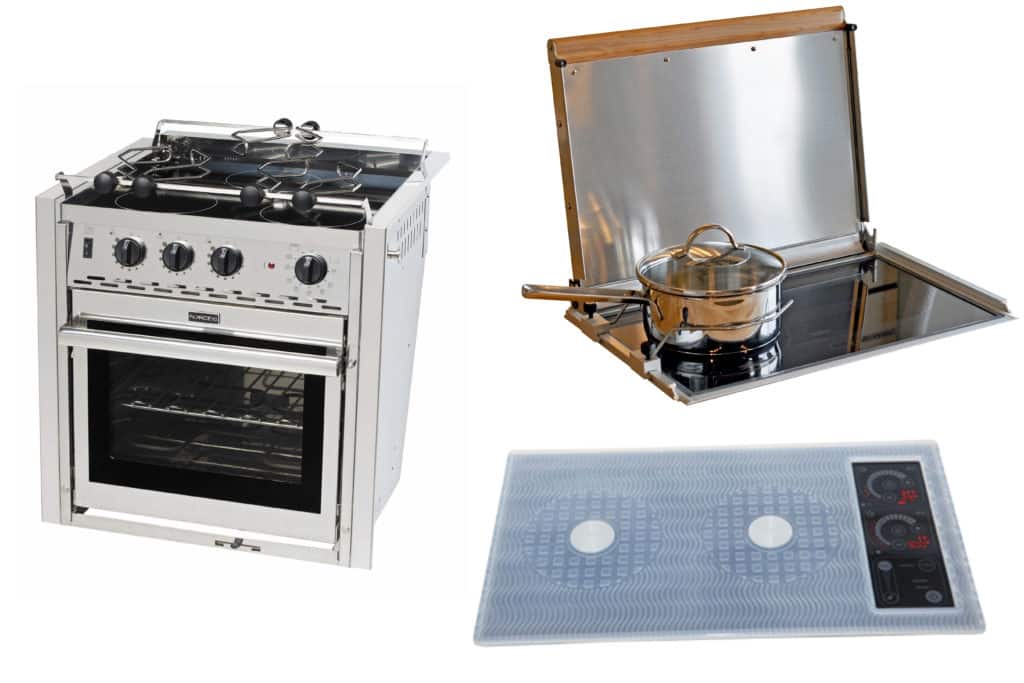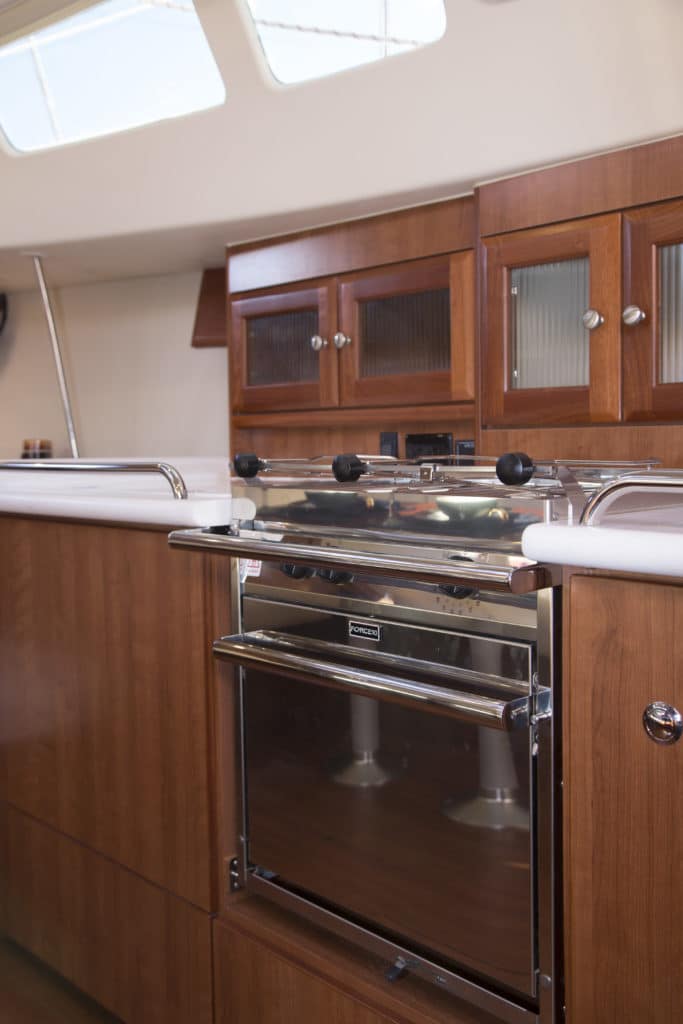
There’s no question about it: On cruising sailboats, an efficient, safe marine stove is as important as good sails, functioning systems and top-notch safety gear. The ability to prepare and enjoy home-cooked meals on board makes for a happy and healthy crew, and at the heart of it all is a reliable stove.
Many owners of pre-owned vessels have inherited the stove that came with the boat—with either happy or hair-pulling results. If you’re in the latter category, or if you wish to retire your once-reliable galley workhorse, it might be time to ponder an upgrade. There are many considerations, but one of the first things you should decide is: Which type of marine stove?
For upgrades, the three most prevalent types of marine stoves rely on liquid petroleum gas (LPG, or propane), nonpressurized alcohol and, in recent years, electric. Other types, such as kerosene and compressed natural gas (CNG) burners, have fallen out of favor for various reasons: Kerosene spills are extremely flammable, burners require priming before lighting, the fuel smells unpleasant, and the odor often permeates interior fabrics and the food itself. While some sailors still swear by it—it’s widely available and burns fairly hot—use of kerosene is waning. CNG made its appearance (along with LPG) in the 1980s, and early on was touted as the “safe gas.” Unlike LPG, it’s lighter than air and can’t settle in the bilges, though fumes can collect in other areas of the boat that aren’t well ventilated—and it still can explode. Today it’s hard to find and rarely used.
Butane, another form of liquid gas, has been used for years to fuel small, portable one- or two-burner stoves equipped with small canisters of fuel. Popular on smaller sailboats for simple cooking, and on some cruising boats as an inexpensive backup to the existing galley stove, it can be useful for preparing coffee, tea or one-pot meals without heating up the galley too much, but probably isn’t under consideration for an upgrade.
Diesel stoves are not widely considered either, but if you dislike propane and alcohol, stoves and ovens that use diesel forced-air technology, such as those made by Wallas in Finland (imported by Scan Marine), might be worth a look. Prices range from $2,500 to $5,000.
Marine Propane Stoves
On most production cruising boats built from the mid-1980s on, marine propane stoves and ovens have been the rule. When you’re considering an upgrade, they are an excellent choice, though there remain skeptics who are either unwilling to install and maintain a propane system, or are downright terrified of propane and actually switch to an alcohol system for precisely this reason. LPG is heavier than air, and fumes can settle in the bilge if proper installation, usage and safety protocols aren’t followed, creating the potential for explosion. Most who use propane aboard safely feel that the benefits outweigh the risks: It’s available worldwide, the cost is reasonable, it burns hot and cooks food quickly, it’s odorless while burning, and it’s easy and safe to use as long as you practice strict safety measures. Propane stoves and systems on U.S. boats must meet American Boat & Yacht Council standards, which outline specific parameters for safe installation and use. The West Marine Advisor also offers tips on safe installation.
Marine propane stoves have improved over the years; most newer models have built-in safety thermocouples that automatically stop the flow of gas within seconds if a flame is not present. This feature, plus other required and optional safety measures—such as a leak-detection system, a dedicated exterior tank-storage locker, a simple electric solenoid switch that allows the gas to be shut off manually and remotely, and a vapor detector—are key to safe operation, along with careful use by all aboard. On today’s new-stove market, retailers report that the Force 10 gimbaled two- and three-burner series are top sellers. For a new two- or three-burner range, you’ll need to budget between $1,000 and $2,000, depending on make and model. If you’re short on galley space but still want propane, Eno makes compact two- and three-burner built-in and gimbaled propane cooktops, which sell for $300 to $400.
Marine Alcohol Stoves
Alcohol stoves burn denatured alcohol, and over the years they’ve suffered a bad rap: Older, pressurized models achieved widespread notoriety not for their cooking ability, but for their uncanny knack for setting anything above them (sometimes including the cook) on fire. Pressurized stoves were famously difficult to light; they required pumping and priming with alcohol to get the burners hot enough for sustained cooking, which often led to flare-ups and disaster. Compounding the problem was that an alcohol flame is nearly invisible, resulting in burns from touching a burner that was invisibly lit. Fortunately for fans of this fuel, newer, nonpressurized, highly functional models of marine alcohol stoves are available to eliminate the danger as well as the priming process. The Dometic Origo system uses canisters fitted with wool “wicks” that soak up the alcohol, allowing the fumes to be lit in a controlled way that avoids flare-ups. In addition to being nonexplosive, alcohol stoves are easy to install; every component needed comes with the stove.
But while alcohol has advantages, it also has drawbacks: Like kerosene, it has an odor when the stove is in use that makes some people queasy. It burns at a much lower temperature than either kerosene or propane, using more fuel and taking longer to cook food or even boil water, but fans of alcohol stoves claim they don’t notice or mind the slightly longer cooking times. Though more expensive overall than propane, stove alcohol is widely available in the U.S.; worldwide, it’s harder to come by. Nonetheless, alcohol marine stove proponents cite not having to worry about a possible onboard explosion and ease of installation as two benefits that outweigh all the drawbacks combined. According to retailers, the Dometic Origo 6000 is today’s top-selling alcohol stove/oven, followed closely by Dometic Origo stove-top units. New ranges are priced between $1,500 and $1,800; stove-tops are in the vicinity of $200 to $350.
Electric Marine Stoves
Until recently, electric stoves and ovens were found mainly on large powerboats and superyachts and would not have been a possibility for the average sailboat. But as new boats equipped with generators as standard equipment make their way into the mainstream market, and as more owners of older boats retrofit gensets, electric marine ranges and fixed or portable ceramic cooktops are making inroads. Most U.S.-made boat stoves require 120 volts; if a boat spends much of its nonsailing time at marinas with shore power available, or if running the generator each time the stove is used isn’t a problem, it may be a viable alternative. The price range for a new two- or three-burner electric marine stove and oven is $1,500 to $2,000; for one- and two-burner electric and induction cooktops, from the simple to the sublime, the price ranges from $100 to $900.

Induction Cooking
The newest trend in electric stoves is induction cooking, which cooks food using electromagnetic induction rather than conduction from electric heat or a flame. In simplified terms, when you turn on the stove burner, a metal coil beneath a ceramic cooktop uses alternating current to produce a magnetic field. When magnetic cookware is placed on top, voilà! The pot heats up, but the cooktop remains cool. The advantages seem endless: Induction stoves drastically reduce fire and burn risk, as the cooktop itself does not heat up; they don’t warm up the boat; they cook food fast and efficiently; and because it doesn’t ever get hot, the cooktop is easy to keep clean (and can double as extra counter space). One disadvantage to most electric ceramic cooktops on boats is the lack of rails or clamps to keep pots in place. Another is that induction cooktops require use of specific cookware with magnetic properties; when you replace your existing stove with one, you might also have to replace your pots. Kenyon Marine has addressed the problem of keeping pots on the stove with its innovative new Silken2 two-burner Trimline induction cooktop; it comes with a fitted, patented nonskid silicone mat that can be used during cooking. Another popular induction cooktop is the single-burner unit by Furrion. This technology is new and still evolving. If you’re on the fence about an upgrade, keep a close eye on marine induction stoves — they just may be the wave of the future.
Before You Buy a Marine Stove
Before you start to shop, answer some basic questions: How much stove do you need? How much room do you have in your galley? Where do you plan to cruise? The stove you select depends largely on how—and how often—you use your boat. If it’s a small boat with limited galley space, used mostly for daysails, weekend cruises, and the occasional overnight not far from home waters, a simple stove-top system (nonpressurized alcohol, butane or, if you have shore power, electric or combination alcohol-electric) might suffice. If it’s a midsize boat used for extended vacation or liveaboard cruising, you’ll likely want—and have room for—a marine stove with an oven. If there are only two of you aboard, a two-burner stove and oven might suffice; if you’re a family, consider a three-burner. Measure your space carefully and, unless you want to undertake a major carpentry project, be sure you select a boat stove that fits. (If you own a European-made boat, you’ll likely need to order a metric size.) If you cruise outside the U.S., choose a marine stove that uses fuel that’s available and affordable everywhere you plan to visit.
Depending on where and how you sail, there are also some stove safety features to consider. Almost all marine stoves and ovens are gimbaled, allowing them to swing back and forth, essentially remaining level when the boat is heeled (or rolling at anchor). Your best bet will be to go for a gimbaled replacement. Other safety features should include a sturdy, built-in safety rail around the outer edge to guard against pots sliding off the stove-top; a set of pot clamps to keep pots in place while cooking underway; and a latch that allows the oven door to be securely locked in place.
Choosing and installing a new marine stove doesn’t have to mean jumping from the frying pan into the fire. If you know exactly what you want before you shop and do your research on features and installation, outfitting your sailboat with a new stove that meets your needs will be worth its weight in comfort — not to mention delicious home-cooked meals.
Lynda Morris Childress and her husband, Kostas Ghiokas, cruise and charter their Atlantic 70 cutter, Stressbuster, throughout the Greek Islands.








